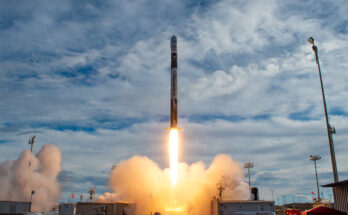by Bill Ostrove, Space Systems Analyst, Forecast International.
International Launch Services (ILS) recently announced that it will introduce a new Proton launch vehicle variant with a larger payload fairing – a clear sign that flexibility is now a key differentiator in the launch vehicle market.[i]
Flexibility has become more important as satellite weights and configurations have become more diverse. For decades, the trend had been to make satellites heavier. The Proton – designed to carry a single heavy satellite into orbit – exceled in those market conditions. Along with the Ariane 5, it dominated the commercial launch services market.
However, as new form factors for satellites have grown in popularity, ILS has found itself unable to meet many of its customers’ demands. Designed to lift heavy satellites, the Proton isunnecessarily large and expensive when it comes to carrying smaller satellites into orbit. Moreover, its 4-meter payload fairing means it also cannot carry newer high throughput satellites (HTS), which are becoming increasingly popular with companies like ViaSat. In the case of HTS platforms, the Proton is able to accommodate the launch mass, but not the larger physical size of the satellites.
These factors have contributed to a decline in Proton launches[ii], from 11 in 2012 to only five in 2016. It should be noted parenthetically that lack of reliability has affected Proton launch rates as well. Launches have been delayed due to investigations into launch failures. And failures have made customers question reliability, sometimes persuading them to switch launch providers.

Other launch vehicles are better positioned to take advantage of the diverging segments – large and small – of the satellite market. Both SpaceX’s Falcon 9 and the Arianespace Ariane 5 have payload fairings with a diameter larger than 5 meters. ULA’s Atlas V offers variants with a 5.4-meter fairing, and China’s new Long March 5 will have a 5.2-meter fairing. So, four launch vehicles with payload fairings of 5+ meters are either on the market or about to enter the market. The Proton is at a distinct disadvantage.

These larger-fairing launch vehicles are also able to accommodate smaller satellites. The Falcon 9’s low price makes it attractive to small satellite operators. While the Ariane 5 is more expensive, it typically launches with two primary payloads: a larger one and a smaller one. By offering two launch slots, Arianespace is able to offer lower prices to customers with smaller satellites. Both SpaceX and Arianespace will launch a mid-size satellite for about $60 million.[iii]
For years, ILS’ prices ranged between $80 million and $90 million. More recently, the company began offering launches starting at $65 million[iv], a price still higher than its competitors. Furthermore, the large Proton remains expensive to produce, meaning the lower launch price will cut into profits.
ILS is responding aggressively to the changing market. In 2016, it revealed that it is working with Proton prime contractor Khrunichev to develop new, smaller variants of the Proton launch vehicle. Although recent reports suggest that the smallest of these variants may not be developed after all, the introduction of even one new smaller variant will enable ILS to compete in the smaller-satellite market. The new variant will be able to carry up to 5,000 kg to orbit at a lower cost than the older Proton.[v] That will enable ILS to be more competitive while staying profitable. Now, with the introduction of a larger payload fairing, ILS will also be able to compete to carry large high throughput satellites into orbit. Operators will be willing to pay for the larger Proton in order to get their large satellites into orbit.
ILS is offering new flexibility to its satellite launch customers. In recent years, such flexibility has become a feature of companies that are succeeding in this market.
Please feel free to use this content with Forecast International and analyst attributions, along with a link to the article. Contact Ray Peterson at +1 (203) 426-0800 or via email at ray.peterson@forecast1.com for additional analysis.

Forecast International offers two Space Systems Forecast products: Launch Vehicles & Manned Platforms, with reports on manned spacecraft, expendable launch vehicles and more, and Satellites & Spacecraft, with coverage ranging from microsatellites to large COMSATs – all complete with technical specifications and forecast details.
[i] http://www.ilslaunch.com/newsroom/news-releases/ils-announces-availability-5-meter-fairing-proton-breeze-m-and-proton-medium-
[ii] http://www.ilslaunch.com/newsroom/news-releases/ils-announces-availability-5-meter-fairing-proton-breeze-m-and-proton-medium-
[iii] http://aviationweek.com/awin/spacex-says-falcon-9-compete-eelv-year
[iv] http://spacenews.com/price-cuts-part-of-multipronged-strategy-to-win-back-proton-customers/
[v] http://spacenews.com/ils-plans-larger-proton-payload-fairing-defers-work-on-smaller-proton-variant/
A military history enthusiast, Richard began at Forecast International as editor of the World Weapons Weekly newsletter. As the Internet grew in importance as a research tool, he helped design the company's Forecast Intelligence Center and currently coordinates the EMarket Alert newsletters for clients. Richard also manages social media efforts, including two new blogs: Defense & Security Monitor, covering defense systems and international issues, and Flight Plan, which focuses on commercial aviation and space systems. For over 30 years, Richard has authored the Defense & Aerospace Companies, Volume I (North America) and Volume II (International) services. The two books provide detailed data on major aerospace and defense contractors. He also edits the International Contractors service, a database that tracks all the contractors involved in the programs covered in the FI library. More recently he was appointed Manager, Information Services Group (ISG), a new unit that encompasses developing outbound content for both Forecast International and Military Periscope.




